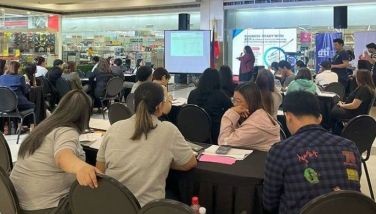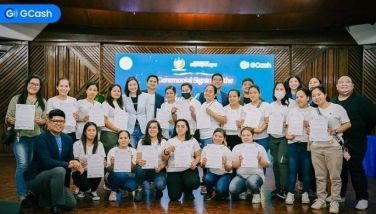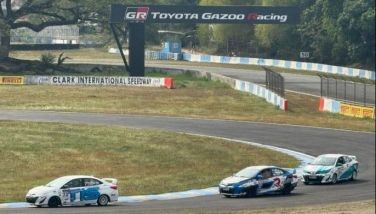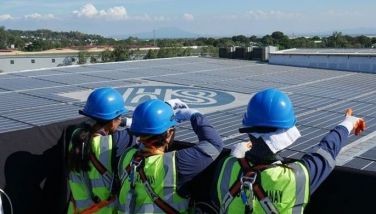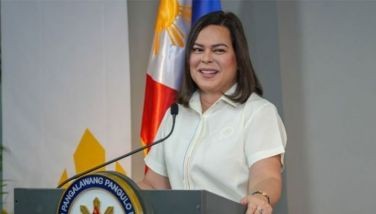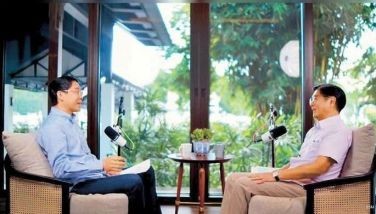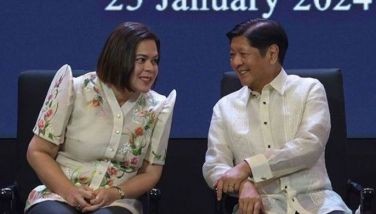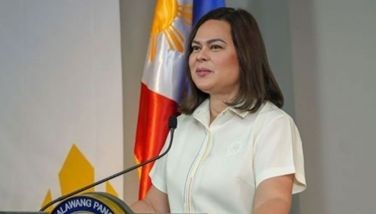P2.4-B pre-campaign ads: Bong Go, Marcos, Roxas, Roque top spenders
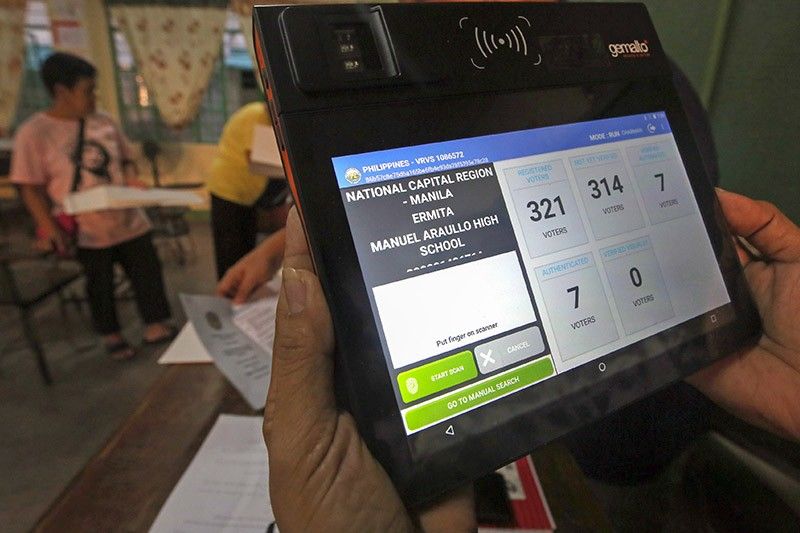
Money and the May 2019 elections
(Philippine Center for Investigative Journalism) — To the last, they have pledged to fight poverty and corruption, promote health and education, protect the environment, and serve the poor who make up a majority of over 60 million registered voters.
Yet while politics may divide them, money, apparent access to state funds and facilities, and donations from private pockets and public coffers that could have funded their pol ads, seem to unite those with biggest pre-campaign adspend among the senatorial candidates in the upcoming May elections.
Competing for only 12 Senate seats are 61 candidates, making for a rather crowded pool. Not surprisingly, based on data from Nielsen Media, the major candidates for senator from the administration and opposition parties and some independents appear to have already turned the May 2019 polls into a virtual marketplace for votes, starting with a circus of pre-campaign ads on air, on ground and online.
From January 2018 to January 2019, the combined ad spending of 18 candidates on TV, radio, print, and outdoor ads have reached P2.4 billion, by the rate card of media agencies monitored by Nielsen Media. Yet, just a few have net worth values bigger than their respective adspend.
In fact, those with the lowest net worth, the biggest liabilities, and the smallest cash on hand are, as of their latest Statement of Assets, Liabilities, and Net Worth, among the biggest spenders on pre-campaign ads.
Possible sources of those millions of pesos poured into pre-campaign ads include hidden wealth, public funds, and even indirect bribery from private donors.
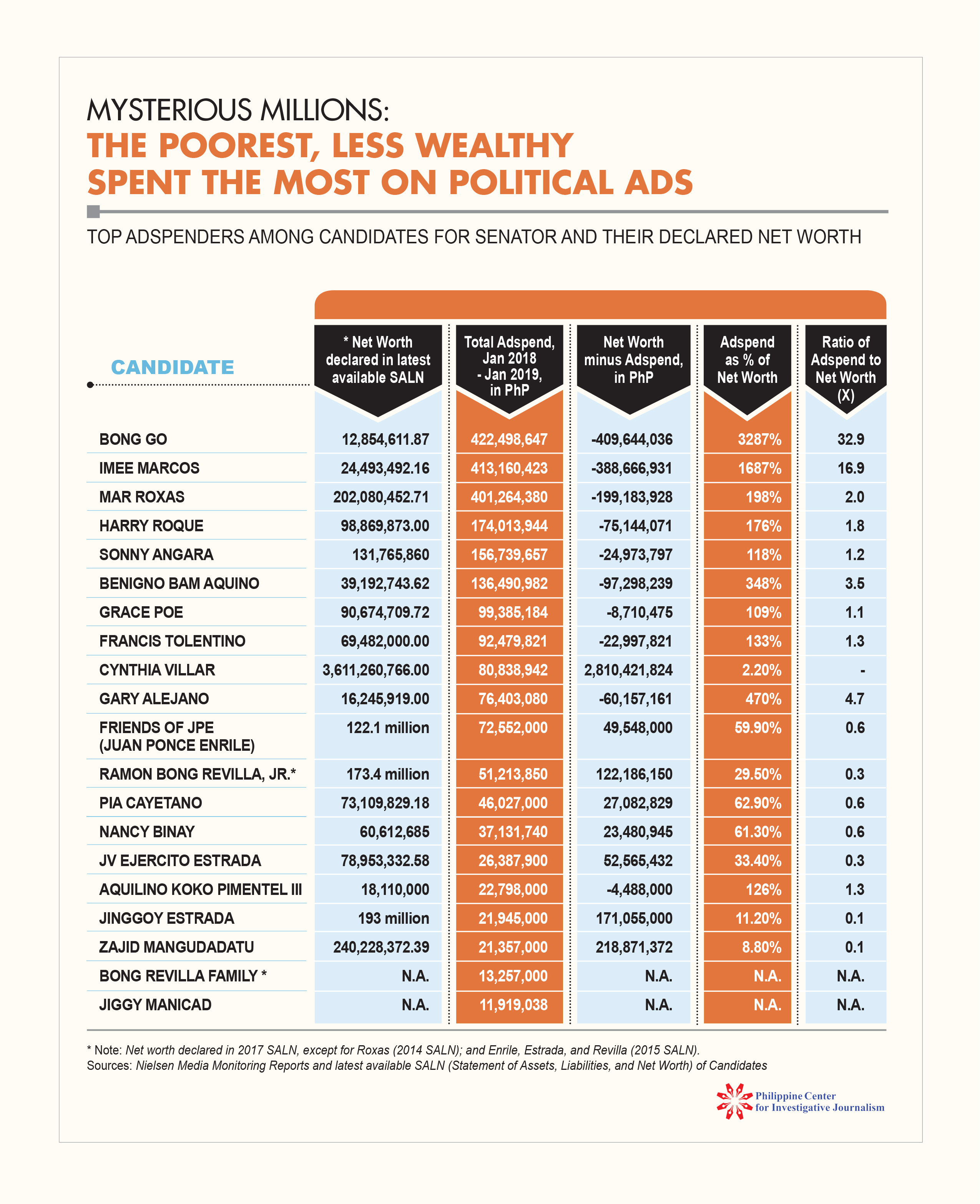
‘Policacy’ ads
“The fact that the net worth of these candidates could not support the costs of the(ir) adspend necessarily gives rise to the presumption that either the candidate has hidden wealth or that these were donated to the candidate while in public office,” remarks lawyer Christian Robert S. Lim, a former Election Commissioner who headed the Campaign Finance Office (CFO) of the Commission on Elections (Comelec) until 2018.
Under the Revised Penal Code, Lim says, it is a criminal offense to receive gifts by reason of their office. “This is called indirect bribery,” he says.
By Nielsen Media’s monitoring of television, radio, print, and outdoor “social concern” ads from January 2018 to January 2019, easily the most moneyed candidates include 12 of the 14 candidates endorsed by President Rodrigo Duterte, those recently resigned from executive positions, and those running for re-election or returning to the Senate.
They were featured as the “advertiser,” “brand” and “product” in these ads that ran starting June 2018, or while they were still government officials. In advertising circles, these ads also go by the moniker “policacy” or political advocacy ads.
PCIJ has subscribed to Nielsen Media’s monitoring reports on the political adspend of the candidates for elective posts since 2010. PCIJ data show that the re-electionist candidates for senator today are in truth repeat offenders — they had also splurged millions on pre-campaign ads in elections past.
In 2010, the combined pre-campaign adspend of six candidates for president and four for vice president from Nov.1, 2009 to Feb. 8, 2010 amounted to P1.472 billion.
In 2013, the leading candidates for senator incurred pre-campaign ads worth P892 million, from Jan. 1 to February 11, 2013.
From Jan. 1, 2015 to Jan. 21, 2016, about 105,000 pre-campaign ads valued at P6.7 billion featured the candidates for president and vice president in the May 2016 elections.
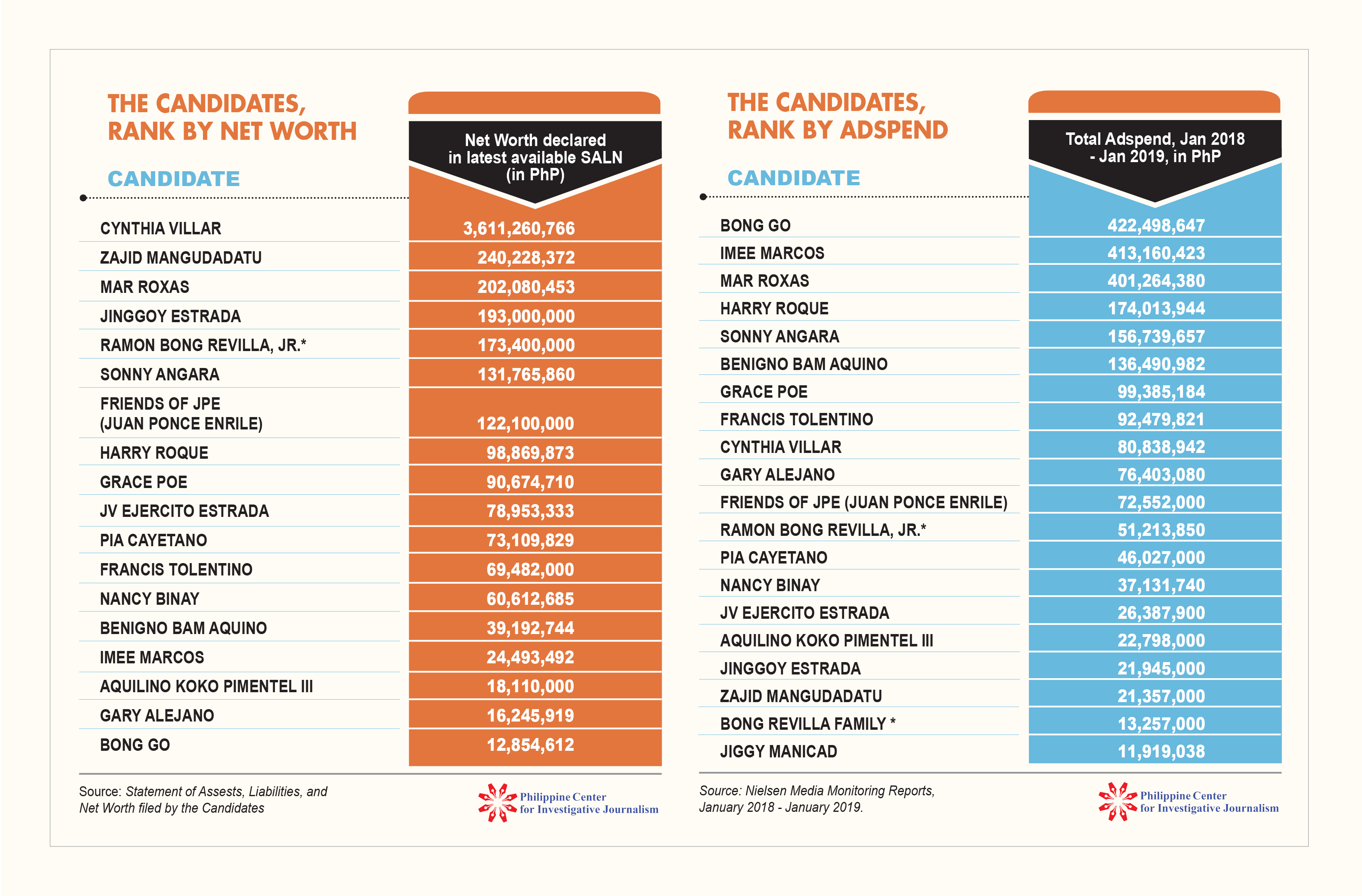
Bong Go net worth: P12.8-M
In the runup to the May 2019 polls, the 12 candidates under the Hugpong ng Pagbabago-Partido Demokratikong Pilipino (HNP-PDP-LABAN) banner and endorsed by Duterte, incurred a combined adspend of P1.32 billion in the last 13 months ending January 2019.
A third of this total or P422,498,647 consists of ads purchased by and for Christopher Lawrence “Bong” Go, the biggest spender thus far among all 61 candidates for senator.
The mystery is stark: Go — formerly special assistant to the president — is the poorest of the top adspenders with a declared net worth of only P12.85 million, and cash on hand/in bank of only P3.9 million, as of his December 2017 SALN. His P422-million total ad buys amount to 3,287 percent of his net worth.
Put another way, he bought political ads 32.9 times in value compared to his total personal wealth. Minus all that he owns, P409.6 million was the unfunded balance of his ad buys that Go might have paid using money from either public or private sources.
In January 2019, Nielsen Media’s monitoring of TV ads only listed Go as the product, brand, and advertiser in at least 1,016 ad spots equivalent to 29,940 seconds of airtime exposure at a cost of P247.9 million.
Nearly one in every three ads (total of 3,261 ad spots) that aired on TV channels last month featured Go. For January 2019 then, Go spent an average of P7.99 million every day on TV ads, or two-thirds of his latest declared net worth.
Marcos, Roque, too
Another Hugpong candidate, Ma. Imelda “Imee” Marcos, the second biggest adspender, repeats Go’s strange story. Marcos, currently the third-term governor of Ilocos Norte, has acquired P413,160,423 worth of ads from January 2018 to January 2019, but has declared a net worth of only P24.49 million and cash on hand of only P2.45 million in her December 2017 SALN. Her adspend comes up to 1,687 percent of her net worth; her adspend deficit, minus all her declared wealth, amounts to P388,666,931.
The fourth placer among the big ad buyers is Harry Roque, a Hugpong-endorsed candidate who quit the Senate race last February 1, reportedly for health reasons.
As of last January 31, however, Roque’s adspend had reached P174,013,944, or P75.1 million more than his declared net worth of P98.87 million, as of December 2017. The former presidential spokesman’s adspend amounts to 176 percent of his net worth, and even his P54.6 million cash on hand and in bank that he reported in his latest SALN.
The other Hugpong candidates who have also incurred pre-campaign ads are re-electionist senators Cynthia Villar, Joseph Victor “JV” Estrada Ejercito, Juan Edgardo “Sonny” Angara, and Aquilino “Koko” Pimentel III; former Sens. Jose “Jinggoy” Estrada, Ramon “Bong” Revilla Jr., and Pia Cayetano (currently 2nd District Representative of Taguig City-Pateros); Maguindanao 2nd District Rep. Zajid Mangudadatu, former Duterte adviser Francis Tolentino, and former TV journalist Jiggy Manicad.
Yet while all of them are among the top 20 pre-campaign adspenders, these candidates’ combined adspend in the last 13 months comes to only a third of the administration slate’s total of more than P1.5 billion, or over P518 million. The bigger two-thirds balance represents the pre-campaign adspend of Go, Marcos, and Roque.
Two other pro-Duterte candidates had not incurred ad buys as of January 2019: former police chief Ronald “Bato” de la Rosa and medical practitioner Willie Ong.
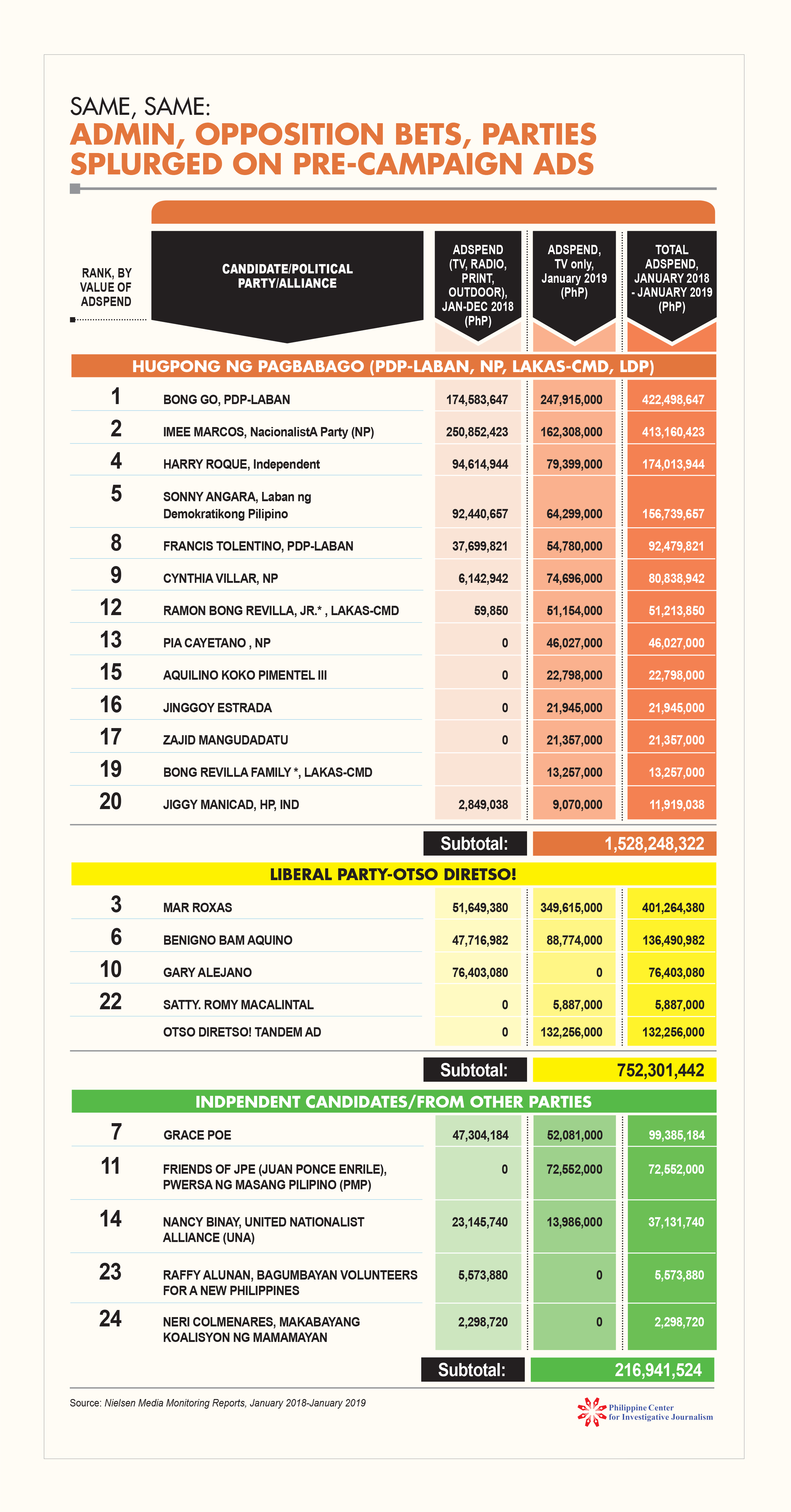
Otso Diretso: P132-M bill
The opposition Otso-Diretso! team of the Liberal Party also had no ads at all in 2018. In January 2019, however, it bought 107 TV ad spots that ran for a total of 2,910 seconds on ABS-CBN and GMA-7 Network. Its adspend bill: P132,256,000.
Three of its candidates are also among the top 20 pre-campaign adspenders, including two of LP’s frontrunners, former Interior and Local Government Secretary Manuel ‘Mar’ Roxas II and re-electionist Senator Paolo Benigno “Bam” Aquino IV. Roxas ranks third with an adspend of P401,264,380, while Aquino is sixth with an adspend of P136,490,982, according to Nielsen Media’s monitoring reports from January 2018 to January 2019.
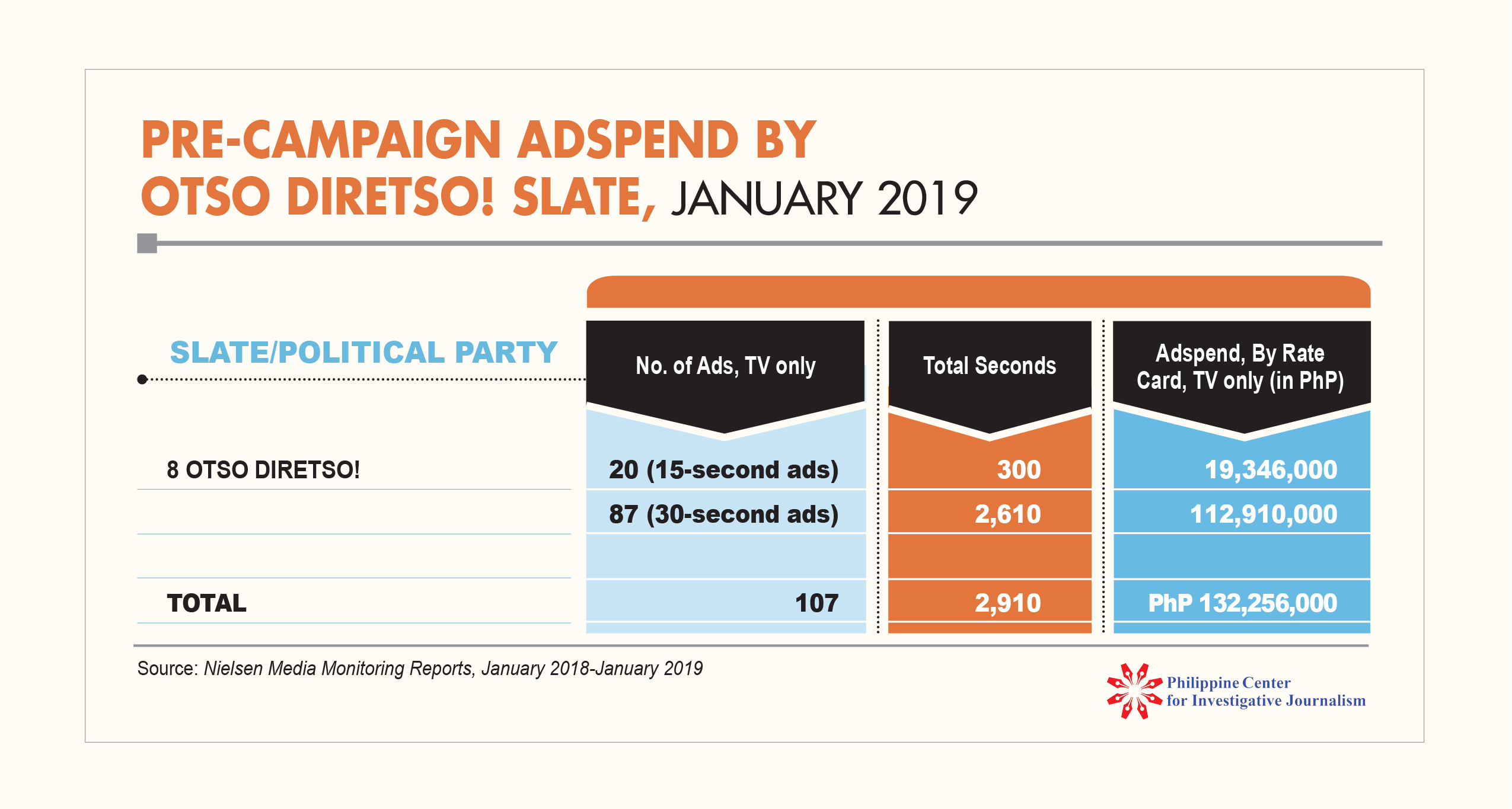
Roxas’s adspending actually shot up sharply in January 2019, during which he bought 570 TV ad spots lasting 16,125 seconds in total. He paid a total of P349.5 million for his mostly 30-second ad spots for that month alone. Aquino’s adspending last month also increased significantly from his total in the entire 2018, reaching nearly P89 million just for TV-ad placements.
By their latest available SALN, Roxas and Aquino are also in deficit spending, in terms of their pre-campaign ad buys.
In his 2014 SALN, the latest available, Roxas declared a net worth of P202,080,452.71. His adspend of P401,264,380 by January 2019 put him in deficit spending by P199,183,928. Roxas thus splurged on ads 198 percent more money than all that he declared he owns.
Aquino, for his part, declared his net worth as of December 2017 at P39,192,743.62, but spent thrice more or P136,490,982 on pre-campaign ads until last month. His adspend is 328 percent of his wealth, for a deficit spending of P97,298,239.
Roxas, Aquino and two more of Otso Diretso!’s eight candidates incurred a combined adspend of P752,301,442 in 13 months ending January 2019. Contributing to this total were Magdalo Party-list Rep. Gary Alejano (10th among the top adspenders) and election lawyer Romy Macalintal who incurred ad buys of P76,403,080 and P5,887,000, respectively during the same period.
Independents spent, too
Five other candidates running under other political parties or as independents had a combined adspend of P216,941,524 from January 2018 to January 2019.
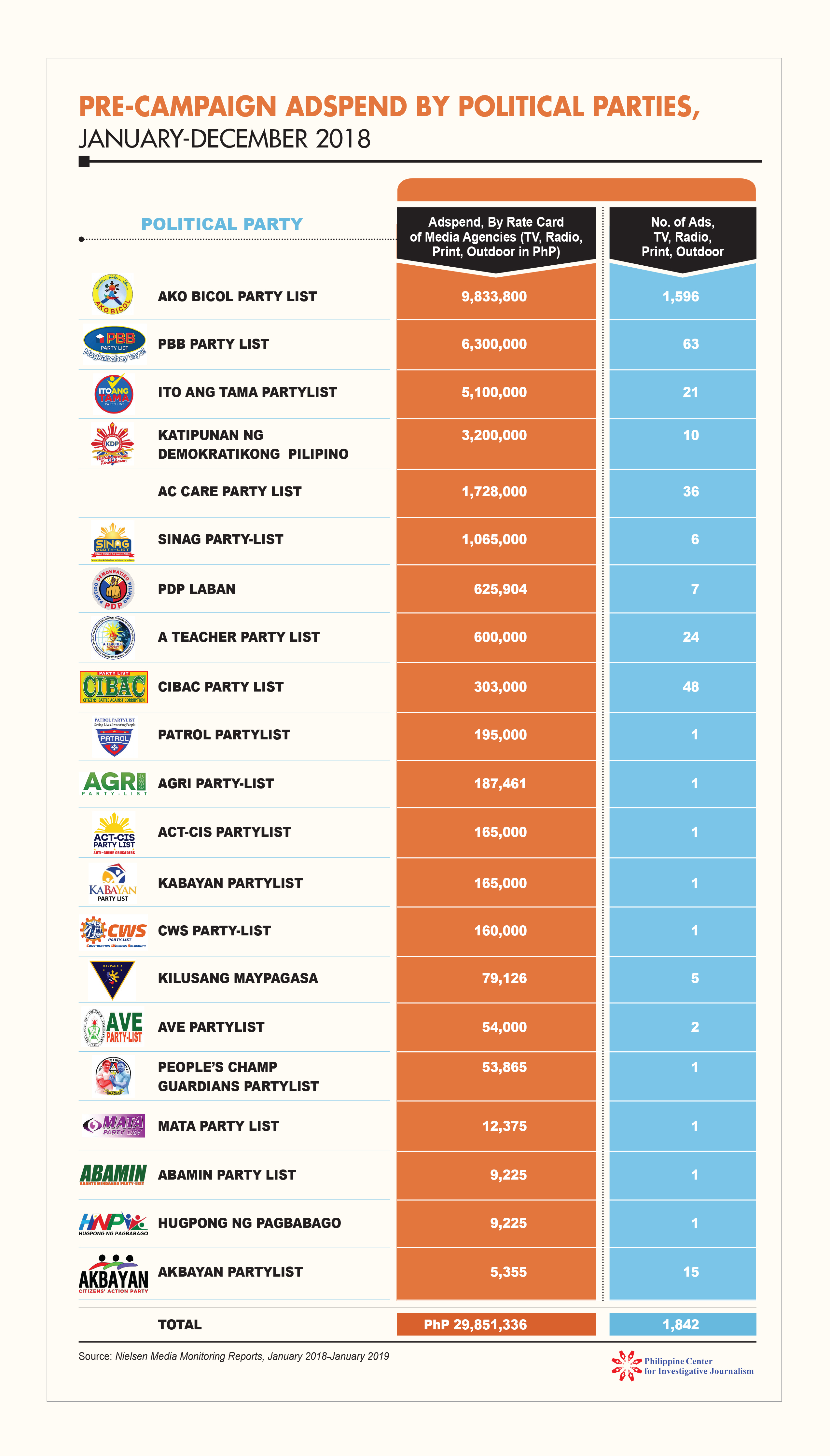
They are re-electionist Senator Grace Poe, with an adspend of P99,385,184; “Friends of JPE” or apparently returning senator Juan Ponce Enrile of Pwersa ng Masang Pilipino, P72,552,000; re-electionist Senator Nancy Binay of the United Nationalist Alliance, P37,131,740; Rafael “Raffy” Alunan of the Bagumbayan Volunteers for a New Philippines, P5,573,880; and Neri Colmenares of the Makabayang Koalisyon ng Mamamayan, P2,298,720.
Alejano, Tolentino, and re-electionists Poe, Ejercito, and Pimentel have all spent more monies on pre-campaign ads than the net worth they declared in their latest SALNs.
Still, it is the case of Bong Go, the candidate with the lowest net worth among the top 20 adspenders, that remains the most intriguing. After all, the poorest managed to buy the most ad spots.
Malasakit Center ads
As early as June 2018, or four months before he filed his certificate of candidacy, paid ads featuring taped voice and video clips of Go had begun airing on TV and radio stations in Manila, Davao City, Cagayan de Oro, and Zamboanga.
At the time, Go was still Duterte’s special assistant. Yet in December 2018, after he was supposed to have resigned when he filed his candidacy for senator, at least 30 ads about the Malasakit Center program of the Department of Health and Department of Social Welfare and Development featured Go as its supposed chief sponsor. The ads aired during the Christmas holidays on television.
Except for promoting Go’s run for the Senate, nothing much is new about the Malasakit Centers. These are actually a refurbished one-stop-shop for indigents seeking medical assistance under the same, usual program for indigents that the DOH, DSWD, Philippine Health Insurance Corp., Philippine Charity Sweepstakes Office, and Philippine Amusement Gaming Corp. have been supporting for years now, even before Duterte became president.
At present, 21 Malasakit Centers have opened across the nation; in all but one, the pilot site in the Visayas, Go had attended events as guest speaker.
The president himself has lent Go’s candidacy a special push, more than any of the other administration candidates. Duterte’s photo appears as “Tatay Digong” side by side with Go as “Kuya Bong” in tarpaulins on the façade of the Malasakit Centers, government agencies, and barangay halls, as well as on posters and billboards all over the country’s towns and cities.
Duterte has also appeared in pre-campaign ads featuring Go as someone whose supposed only vice — bisyo — is “serbisyo” or service.
Must post tarps?
Too, some civil servants have exposed on social-media posts that certain government agencies have been required to post tarpaulins bearing the image of Go.
“Unfortunately,” says former Election Commissioner Lim, “due to a Supreme Court ruling and as restated by the Civil Service Commission in its Memorandum Circular No. 02, Series of 1992,” the president, the vice president, Cabinet members, all other elective officials, and their personal and confidential staff “are deemed to be holding political offices and are not covered by the prohibition on electioneering or partisan political activity.”
Nonetheless, Lim says, “While it may be legal, the same remains to be morally reprehensible as our expectations of government officials who are using official time of the government are best spent on resolving the multitude of problems besetting our country rather than campaigning.”
He adds that such patently partisan actions by the president and senior executive and elective officials set “a bad precedent to create a distinction that the highest officials are exempt from this prohibition while the rest of them have to abide.”
And yet, despite all of Duterte’s special assist for his ex-special assistant, Go seems to still have found it necessary to go on what can be described as an aggressive ad campaign for his senatorial bid.
Started in 2018
In 2018, on various television channels, Go was featured in 519 ad spots, compared with 185 for Roque, 166 for Marcos, and 62 for Tolentino. TV networks require a “pay before broadcast” rule on political ads to compel candidates to pay up before their ads could air.
Also in 2018, out of 21,268 ad spots aired in various radio stations under the “social concerns” subcategory, nearly half or 9,278 ad spots featured “Bong Go” as brand, product, and advertiser.
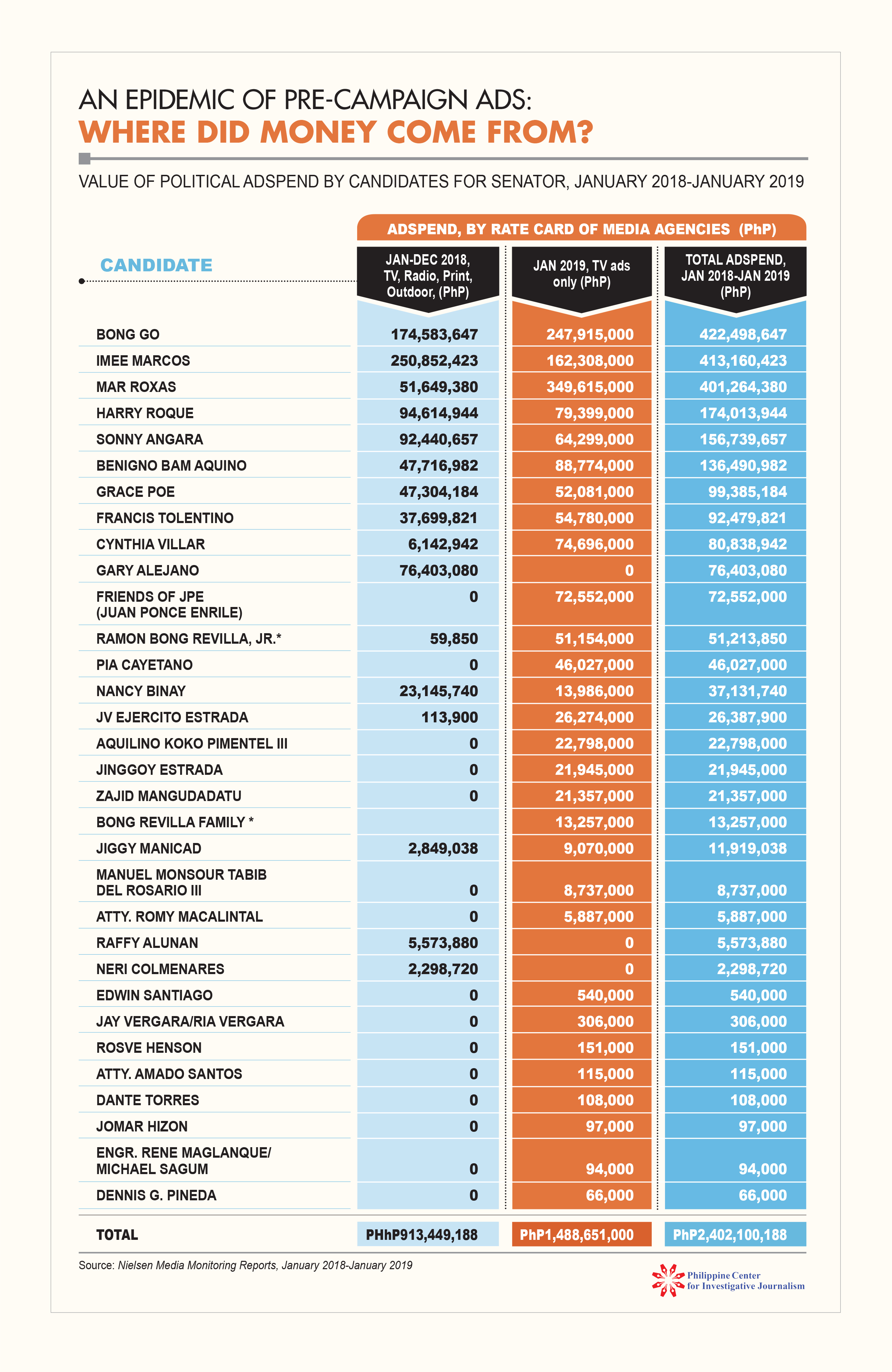
Roque was featured in 3,324 radio ads, Marcos in 2,401 radio ads, and Tolentino in 651 radio ads. LP’s Roxas was featured in 2,299 radio ad spots.
Monitoring reports by Nielsen Media showed that these “social concerns” and “policacy” or political advocacy ads started airing in January 2018, but hit steadily rising charts in June 2018, led by a flurry of ads placed by Go, Roque, and Marcos.
For the whole of 2018, Nielsen Media monitored the adspend of the candidates under the “social concerns” subcategory of ads on TV, radio, print, and outdoor platforms.
In January 2019, Nielsen Media’s monitoring report focused on TV only.
The top adspenders among the candidates for senator, by order of value of TV ads only for the 13-month period ending January 2019, are:
• Bong Go, P422,498,647;
• Imee Marcos, P413,160,423;
• Mar Roxas, P401,264,380;
• Harry Roque, P174,013,944;
• Sonny Angara, P156,739,657;
• Bam Aquino, P136,490,982;
• Grace Poe, P99,385,184;
• Francis Tolentino, P92,479,821;
• Cynthia Villar, P80,838,942;
• Gary Alejano, P76,403,080;
• Friends of JPE (Juan Ponce Enrile), P72,552,000;
• Bong Revilla, P51,213,850;
• Pia Cayetano, P46,027,000;
• Nancy Binay, P37,131,740;
• JV Estrada, P26,387,900;
• Koko Pimentel, P22,798,000;
• Jinggoy Estrada, P21,945,000;
• Zajid Mangudadatu, P21,357,000;
• Bong Revilla Family, P13,257,000; and
• Jiggy Manicad, P11,919,03.
— with research by Vino Lucero and infographics by Arnel Rival, PCIJ, February 2019
- Latest
- Trending










